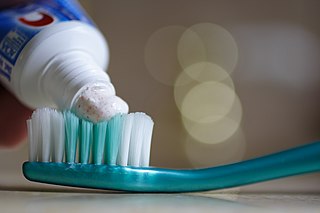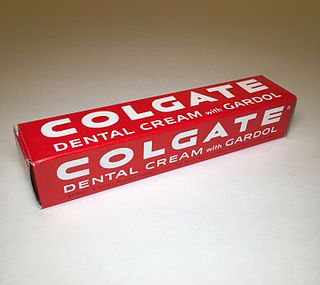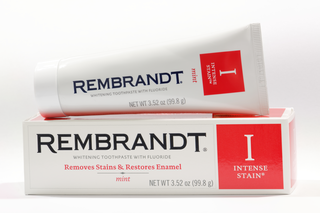
Toothpaste is a paste or gel dentifrice used with a toothbrush to clean and maintain the aesthetics and health of teeth. Toothpaste is used to promote oral hygiene: it is an abrasive that aids in removing dental plaque and food from the teeth, assists in suppressing halitosis, and delivers active ingredients to help prevent tooth decay and gum disease (gingivitis). Owing to differences in composition and fluoride content, not all toothpastes are equally effective in maintaining oral health. The decline of tooth decay during the 20th century has been attributed to the introduction and regular use of fluoride-containing toothpastes worldwide. Large amounts of swallowed toothpaste can be poisonous. Common colors for toothpaste include white and blue.

Colgate-Palmolive Company is an American multinational consumer products company headquartered on Park Avenue in Midtown Manhattan, New York City. The company specializes in the production, distribution, and provision of household, health care, personal care, and veterinary products.
Crest is an American brand of toothpaste and other oral hygiene products made by American multinational Procter & Gamble (P&G) and sold worldwide. In many countries in Europe, such as Germany, Bulgaria, Serbia, Ukraine, Belarus, Russia, Poland, Hungary, Latvia, Romania, Estonia and Lithuania, it is sold as Blend-A-Med, the name of an established German toothpaste acquired by P&G in 1987. In France, Italy, Israel, Sweden, Finland, Argentina, Belgium, the Netherlands, Brazil, the United Kingdom, the Republic of Ireland, Australia, Nigeria, Greece, Uruguay and Colombia, P&G markets similar toothpaste formulations under the Oral-B brand.
Pepsodent is an American brand of toothpaste with the minty flavor that is derived from sassafras. The brand was purchased by Unilever in 1942 and is still owned by the company outside of the United States and Canada. In 2003, Unilever sold the rights to the brand in the North American market to Church & Dwight.

Sodium monofluorophosphate, commonly abbreviated SMFP, is an inorganic compound with the chemical formula Na2PO3F. Typical for a salt, MFP is odourless, colourless, and water-soluble. This salt is an ingredient in some toothpastes.
Ipana was a toothpaste manufactured by Bristol-Myers Company. The wintergreen-flavored toothpaste, with active ingredient 0.243% sodium fluoride, reached its peak market penetration during the 1950s in North America. Marketing of Ipana used a Disney-created mascot named Bucky Beaver in the 1950s.

Tin(II) fluoride, commonly referred to commercially as stannous fluoride (from Latin stannum, 'tin'), is a chemical compound with the formula SnF2. It is a colourless solid used as an ingredient in toothpastes.

Sensodyne is a brand name of toothpaste and mouthwash targeted at people with sensitive teeth. Sensodyne is owned by Haleon and is marketed under the name Shumitect in Japan.

Colgate is an American brand principally used for oral hygiene products such as toothpastes, toothbrushes, mouthwashes and dental floss. Manufactured by Colgate-Palmolive, Colgate's oral hygiene products were first sold by the company in 1873, sixteen years after the death of the founder, William Colgate. The company originally sold soap.

Oral hygiene is the practice of keeping one's oral cavity clean and free of disease and other problems by regular brushing of the teeth and adopting good hygiene habits. It is important that oral hygiene be carried out on a regular basis to enable prevention of dental disease and bad breath. The most common types of dental disease are tooth decay and gum diseases, including gingivitis, and periodontitis.
Dental pertains to the teeth, including dentistry. Topics related to the dentistry, the human mouth and teeth include:

Gingivitis is a non-destructive disease that causes inflammation of the gums. The most common form of gingivitis, and the most common form of periodontal disease overall, is in response to bacterial biofilms that is attached to tooth surfaces, termed plaque-induced gingivitis. Most forms of gingivitis are plaque-induced.

Oral-B is an American brand of oral hygiene products, including toothpastes, toothbrushes, electric toothbrushes, and mouthwashes. The brand has been in business since the invention of the Hutson toothbrush in 1950 and in Redwood City, California.
Cibaca is an oral hygiene brand in India. Originally owned by Ciba Geigy which marketed Cibaca toothpastes and toothbrushes, the brand was bought by Colgate-Palmolive in 1994. After the acquisition, Colgate relaunched the brand as Colgate Cibaca to indicate the change of ownership. The brand is strong in rural India, where it sells in high volumes.

Rembrandt toothpaste is an American brand of toothpaste.
Reach is an American brand of oral hygiene products, including toothbrushes, dental floss, and mouthwash. The brand originated from Reach toothbrushes developed by DuPont in 1976.
Blendax GmbH, founded in 1932 in Mainz, was a German manufacturer of personal hygiene products and toothpaste between 1936 and 2002. With an annual production of 43 million tubes of toothpaste, it was at one time Europe's largest toothpaste producer.

Joseph Charles Muhler was an American biochemist and dentist who was responsible for the development of Crest Toothpaste.










